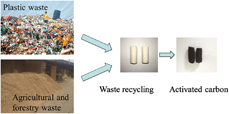Crossref Citations
This article has been cited by the following publications. This list is generated based on data provided by
Crossref.
Wang, Lele
Chen, Shanshan
Wu, Pengcheng
Wu, Keliang
Wu, Jianning
Meng, Guihua
Hou, Juan
Liu, Zhiyong
and
Guo, Xuhong
2020.
Enhanced optical absorption and pollutant adsorption for photocatalytic performance of three-dimensional porous cellulose aerogel with BiVO4 and PANI.
Journal of Materials Research,
Vol. 35,
Issue. 10,
p.
1316.
Li, Changheng
Huang, Qing
Zhang, Haixiang
Wang, Qingqing
Xue, Rixin
Guo, Genmao
Hu, Jie
Li, Tinghang
Wang, Junfeng
and
Hu, Shan
2021.
Characterization of Biochars Produced by Co-Pyrolysis of Hami Melon (Cantaloupes) Straw Mixed with Polypropylene and Their Adsorption Properties of Cadmium.
International Journal of Environmental Research and Public Health,
Vol. 18,
Issue. 21,
p.
11413.
Draoua, Zohra
Harrane, Amine
and
Adjdir, Mehdi
2021.
Preparation, characterization and application of the nanocomposite PCL-PEG-PCL/Bentonite for the removal of methylene blue (MB) dye.
Research on Chemical Intermediates,
Vol. 47,
Issue. 11,
p.
4635.
Li, Lixin
Wang, Jie
Jia, Chao
Lv, Ying
and
Liu, Yan
2021.
Co-pyrolysis of cyanobacteria and plastics to synthesize porous carbon and its application in methylene blue adsorption.
Journal of Water Process Engineering,
Vol. 39,
Issue. ,
p.
101753.
Wang, Jia
Yang, Zhinian
Wang, Hao
Wu, Shuangrong
Lu, Huan
and
Wang, Xingguo
2021.
Decomposition process of cefotaxime sodium from antibiotic wastewater by Up-flow Blanket Filter (UBF) reactor: Reactor performance, sludge characteristics and microbial community structure analysis.
Science of The Total Environment,
Vol. 758,
Issue. ,
p.
143670.
Zhou, Dengfeng
Li, Daiyuan
Li, Ang
Qi, Mingli
Cui, Dapeng
Wang, Hui
and
Wei, Huige
2021.
Activated carbons prepared via reflux-microwave-assisted activation approach with high adsorption capability for methylene blue.
Journal of Environmental Chemical Engineering,
Vol. 9,
Issue. 1,
p.
104671.
Onwucha, Chizoom N
Ehi-Eromosele, Cyril O
Ajayi, Samuel O
Siyanbola, Tolutope O
and
Ajanaku, Kolawole O
2022.
Valorizing waste PET bottles into Li-ion battery anodes using ionothermal carbonization.
Nanomaterials and Energy,
Vol. 11,
Issue. 3-4,
p.
92.
Li, Lixin
Lv, Ying
Wang, Jie
Jia, Chao
Zhan, Zhaoshun
Dong, Zilong
Liu, Lilai
and
Zhu, Xiangdong
2022.
Enhance pore structure of cyanobacteria-based porous carbon by polypropylene to improve adsorption capacity of methylene blue.
Bioresource Technology,
Vol. 343,
Issue. ,
p.
126101.
Sarkar, Binoy
Dissanayake, Pavani Dulanja
Bolan, Nanthi S.
Dar, Jaffer Yousuf
Kumar, Manish
Haque, Md Niamul
Mukhopadhyay, Raj
Ramanayaka, Sammani
Biswas, Jayanta Kumar
Tsang, Daniel C.W.
Rinklebe, Jörg
and
Ok, Yong Sik
2022.
Challenges and opportunities in sustainable management of microplastics and nanoplastics in the environment.
Environmental Research,
Vol. 207,
Issue. ,
p.
112179.
Khan, Moonis
Alqadami, Ayoub
Wabaidur, Saikh
and
Jeon, Byong-Hun
2023.
Co-Carbonized Waste Polythene/Sugarcane Bagasse Nanocomposite for Aqueous Environmental Remediation Applications.
Nanomaterials,
Vol. 13,
Issue. 7,
p.
1193.
Lv, Xifeng
Cao, Huan
Zhang, Rui
Shen, Xuehua
Wang, Xiaodong
and
Wang, Fang
2023.
Waste Plastic Polypropylene Activated Jujube Charcoal for Preparing High-Performance Phase Change Energy Storage Materials.
Nanomaterials,
Vol. 13,
Issue. 3,
p.
552.
Ghritalahre, Bhupendra
Bhargav, Vinod Kumar
Gangil, Sandip
Sahu, Parmanand
and
Sahu, Ravi Kumar
2023.
Next generation bio-derived 3D-hierarchical porous material for remarkable hydrogen storage – A brief critical review.
Journal of Power Sources,
Vol. 587,
Issue. ,
p.
233648.
Maria Jose, Lolly
Anna Thomas, Susmi
Aravind, Arun
Ma, Yuan-Ron
and
Anil Kadam, Sujit
2023.
Effect of Ni doping on the adsorption and visible light photocatalytic activity of ZnO hexagonal nanorods.
Inorganic Chemistry Communications,
Vol. 147,
Issue. ,
p.
110208.
Wiśniewski, Marek
Moszczyńska, Julia
and
Liu, Xinying
2024.
Room-Temperature Oxygen Dissociative Chemisorption on Carbon Surface–Experimental Evidence.
Langmuir,
Vol. 40,
Issue. 1,
p.
193.
Chen, Hao
Zhu, Kai
Yuan, Chuan
Cao, Bin
Wei, Manman
Zheng, Anqing
Babadi, Arman Amani
and
Wang, Shuang
2024.
Co-pyrolysis and activation of microalgae and waste polypropylene in the synthesis of nitrogen doped and porous carbon for pollutant adsorption.
Algal Research,
Vol. 79,
Issue. ,
p.
103452.





